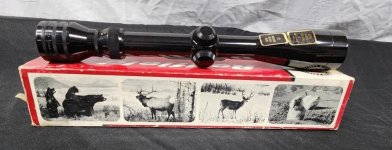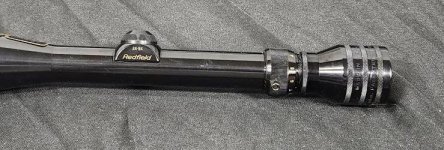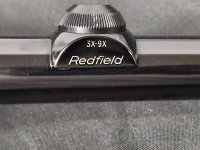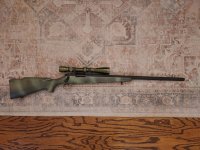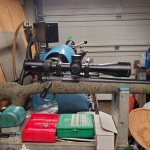Warning to everyone - This is an extremely long post (31 paragraphs, including this one!!!), but it's a very detailed USMC M40 clone build guide. This is probably the most complete M40 build guide published, and I give different options for various parts. I guarantee that there's useful information in here for everyone, so please read or skim this post! There's a few things that I didn't cover, but it's long enough as it is (I can always update it with more information). This started out as a specific response to the OP's build, but it gradually developed into a massive, all-encompassing M40 build guide.
@Chris831
You don't need to spend a lot to have a great competition M40 build. You already have the stock, so it's just your personal time working on it so that it's perfect. I've already done all the heavy listing with the free research I've provided, so just use those measurements when working on your wood stock. Take your time on it and hand fit the parts to the stock. You or your gunsmith will bed the barreled action and bottom metal, but you'll still want a nice fit for these parts when you're carving up your stock (make sure the bottom metal and buttplate are nice and flush). When you're finished with carving up your stock, use some boiled linseed oil (BLO) to seal the wood and make the stock look amazing!
If you don't already have the specific Remington 16601 aluminum buttplate, you'll probably get one with your 1960's vintage donor rifle. If you're not using a vintage donor rifle, the correct Remington 16601 buttplates are easy to find. Please let me know if you nees one, I have a bunch and can send you one for free. Remember to reanodize or paint your entire buttplate black, you don't want the shiny silver raw aluminum sides like what's on the commercial Remington rifles. All USMC M40's had fully anodized black 16601 buttplates, none of them ever has exposed metal sides like the commercial rifles that used the same buttplate. The buttplate should be anodized black, and the trigger guard should be anodized a dark gray.
If you don't already have a barrel, get a Bartlein barrel on order!
@Frank Green makes the best barrels you can buy, and he can make them in the original USMC M40 profile (Remington varmint profile). He can also make exact spec M40A1 barrels too, I send him one of my original circa 1978 USMC M40A1 barrels and he took the measurements. He did the same with an original circa 1966 USMC M40 barrel another well known collector sent him many years ago, so you can be sure that you will have the 100% correct profile for your new USMC M40 barrel. It might be a little bit more money than other barrels, but it's not just the correct M40 profile, it's also one of the best, most accurate barrels that you can buy (which is pretty important if you plan on using the rifle in competitions).
A Bartlein M40 profile barrel blank is probably under $500. You don't need an expensive Bartlein barrel blank, you can can get cheaper ones that are in the correct Remington varmint profile (either from the barrel company or turned by the gunsmith doing the build). A cheaper barrel will save you some money, but I recommend a high end Bartlein barrel of you're using this rifle competitively.
As for the scope and mount, grab an original circa 1960's Redfield 3-9x glossy black commercial scope off eBay or wherever, and send it to
@tokiwartooth (if he's still anodizing scope, which I really hope he's still doing) for matte green anodizing. Use a gen 1 (not gen 2) Redfield 3-9x scope with the low elevation/windage turret caps. The commercial scopes will be glossy black, but don't worry about the finish, you'll anodize or paint it green. Also, don't worry about trying to find the correct/rare reticle and rangefinder "tombstone". Just get whatever reticle you prefer or whatever is available. Just make sure the external features are correct. A 1960's vintage gen 1 Redfield 3-9x scope with correct external features should be under $500. The anodizing or painting might run a few hundred dollars.
The scope mount and rings are going to be some of your cheapest parts! Just go on eBay to buy a vintage Redfield 700SA marked scope base that will fit your Remington 700 short action receiver, and a set of Redfield 1" low height 4 top screw scope rings (both the base and rings will be glossy blued, not matte finish or anything else). You need a very specific type of Redfield 700SA scope base, let me know if you need photos and information about the correct type. Redfield probably made a dozen different 700SA bases over the years, and some of them are quite different looking than the one you need (don't be fooled into buying a lightweight 700SA base or any other incorrect type).
Your vintage Redfield 700SA scope base will probably have rounded corners, which were used on later non-USMC M40's and on USMC transitional M40A1 rifles. The correct Redfield 40X scope base was used on the USMC M40 rifles, but they're impossible to find and will cost $2,000+ for just the scope base! A key feature of the Redfield 40X USMC M40 scope base is the square corners, instead of the roundes ones that the Redfield 700SA scope bases are known for. There are exceptions to this rule, but I'm not getting into that now.
You can use the round corner 700SA base just the way it is (absolutely nothing wrong with that for a clone, since some 40X bases did have round corners), or you can have the corners on the 700SA base squared off. If you want square corners on your 700SA base, ask your gunsmith to weld the corners up, square them off, and then reblue the base. If you want, you could also have your gunsmith weld the 700's marking on the bottom of the scope base and have him remark it 40X.
Remarking the bottom 40X after squaring off the corners won't make a fake 40X base, and it won't fool someone looking closely at it. The reason is because the original 40X bases are different than the original 700SA bases, and have different screw hole and scope ring placement on the base itself. When done correctly, the scope base will look like the original USMC M40 40X scopes bases, and it will probably cost under $100 for your gunsmith to do this custom work to the base. But, like I said, this is just cosmetic and isn't truly necessary to do, unless you really want the square corner look.
The scope rings are much easier to deal with than the scope base! Just get a nice set of vintage Redfield 1" diameter, low height, 4 top screw, glossy blued scope rings. Don't get a different diameter, don't get the medium or tall height, and don't get the 2 top or bottom screw rings. Just get rings with the correct features that I listed, don't deviate from the correct features. The original USMC M40 scope rings were marked on the bottom with either 1-64 or 1-66. You can try to find rings marked this way, but it's not necessary unless you're building an extremely detailed USMC M40 clone.
The 1-64 and 1-66 marked scope rings will also cost you over $100 for a set of the correct ones (low height, 1" diameter, etc.). Be aware of idiot sellers trying to pass off medium height 1-64 and 1-66 marked scope rings! They are lying asaholes who are trying to take advantage of people! The USMC M40's never used medium height scope rings, and the USMC transitional M40A1's never used 1-64 or 1-66 marked medium scope rings (the transitional A1's only used unmarked medium rings). You'll save a lot of money by just spending $20 on a set of unmarked Redfield scope rings with the other correct features (1" diameter, low height, 4 top screws). You'll never see the markings on the underside, so save some money here, and get the unmarked rings for your competition rifle.
I don't know if you have a donor rifle yet, but early 1960's vintage Remington 700 short action 6 digit serial number rifles are very easy to find. There's pretty much no excuse not to use one, unless you really don't have any money to spend. The correct USMC M40 serial number ranges are 221xxx, 224xxx, and 322xxx. However, if you find a donor rifle in one of these 3 serial number ranges on Gunbroker or other public auction, expect to get into a bidding war with high level M40 collectors/cloners. A donor rifle in those 3 correct USMC M40 serial number ranges will easily sell for $3,000 to $4,000+ (especially the 221xxx and 224xxx ranges, they're worth more than the 322xxx range receivers).
You should be looking for any Remington 700 short action donor rifles with correct features (correct bolt handle, bolt shroud, bolt face diameter, tall safety lever, split sear trigger, 16601 aluminum buttplate) that are in the 6 digit serial number range. The 200xxx serial number should start in early 1966 and it will go up to about 350xxx or so in mid 1968 (right before the 1968 Gun Control Act). So, search for Remington 700 short action donor rifles from about late 1965 to mid 1968. Anything within that time-frame will be great for a 6 digit serial number donor rifle! Look for numbers like 222xxx or 223xxx, those are circa 1966 receivers that are right between thr 221xxx and 224xxx serial number ranges. Just decide if you want a 2xxxxx or 3xxxxx receiver, and go from there. The 2xxxxx range is far more popular than 3xxxxx range, since the 322xxx range isn't very well known.
Look for .308 caliber donor rifles in your serial number range, since that those rifles will have the correct bolt face diameter (.470") you'll need for the 7.62x51 ammo that you'll be using in your M40 clone. Also look for other calibers that have the bolt face diameter you need, that will help you expand your search for donor rifles. Other calibers with the same .470" bolt face diameter as the .308/7.62x51mm include .22-250 and .358 Winchester. Even though calibers like 6.5 Creedmoor have the correct bolt face diameter you need, they are modern calibers and weren't around back in 1966. So, look for old calibers other than .308, it will help you widen your search and make things a little bit easier!
Check out the opening post in this thread for a list of bolt face diameters and the calibers associated with each bolt face size. Reference this list when you're looking at donor rifles that aren't chambered in .308:
https://www.longrangehunting.com/threads/bolt-face-diameters.36661/
Here's a list of short action calibers with a bolt face diameter of .470", which is the correct bolt face size for an M40 chambered in 7.62x51mm (this caliber list is taken directly from the link above this sentence). I reformatted this caliber list so that it was easy to use. Keep a copy of this list somewhere close by, and use it to find the perfect donor rifle for your next M40 clone build!
.225 Winchester
.22-.250 Remington
6mm Norma BR
.243 Winchester
6mm Creedmoor
.250 Savage
.260 Remington
6.5-.284 Norma
6.5 Creedmoor
7-08 Remington
.284 Winchester
.300 Savage
7.62x51mm NATO
.308 Winchester
.338 Federal
.35 Remington
.358 Winchester
Now take a look at the Gunbroker link right below this paragraph. This GB auction is for a great 211xxx rifle chambered in .243 Winchester. This rifle is extremely close to the 221xxx USMC M40 serial number range, and the .243 Win caliber has the same .470" bolt face diameter as the 7.62x51mm. You're able to use the receiver, bolt, trigger with safety lever, bottom metal, and 16601 buttplate from this donor rifle. That's a lot of parts from 1 purchase! The bottom metal looks great, use it as is on your M40 clone. The trigger has the correct tall safety and it will also have a split sear. You can't get all of these great parts if you buy a cheaper modern Remington receiver. You can also sell the stock and barrel to recoup some of the money spent acquiring the donor rifle. The buy-it-now price is $1,300, which is pretty great for all that you're getting off of this donor rifle. I don't have any affiliation with this seller, I just wanted to show what a good doner rifle near the USMC M40 serial number range looks like and how many parts can be salvaged off of it. I also wanted to show that you don't need to only look for .308 caliber donor rifles, you can use any donor rifle with a caliber that has a .470" bolt face, so set your Gunbroker saved searches accordingly. Check out this M40 donor rifle:
https://www.gunbroker.com/Item/1036544638
Expect to pay $800 to about $1,500 for a nice 6 digit serial number donor rifle with the correct features (these will be outside the 221xxx, 224xxx, and 322xxx serial number ranges). Don't both with the 3 expensive correct USMC M40 serial number ranges, unless you find one for a great price at a gunshow or store (anywhere that's not a public auction that won't reach $4k).
If you want to save a lot of money, you can just buy a $500 newer production RR prefix serial number donor rifle, and use that for the build. However, there's a ton of differences between vintage and modern Remington 700 receivers:
● The serial number range on modern receivers aren't in the correct USMC M40 serial number ranges
● Modern receivers have a laser engraved serial number and "Remington 700" marking, whereas vintage receivers have stamped information (laser engraving is so sterile/bland/heartless, stamp receivers are always better! This also applies to AR15 clone lower receivers!)
● The "Remington" marking on the left side of modern receivers is not underlined, whereas the "Remington" marking on vintage receivers is underlined
● Modern bolt handles are too thick
● Modern bolt shroud are too long
● Modern Remington trigger sears and safety levers are wrong
● The inside of a modern receiver has an anti-binding bolt rail, whereas the inside of a vintage receiver doesn't
● Modern bolts have a cut in the right lug that engages with the receiver's anti-bind right rail, whereas the vintage bolts don't have a cut in the right lug and the right lug rides above the right rail in the receiver (you also can't use a vintage bolt in a modern receiver, unless you make the cut in the vintage bolt's right lug so that it can engage the modern receiver's anti-bind right rail. You can easily test this out yourself by taking a vintage bolt and a modern receiver, and trying to put the bolt in the receiver, it's just not going to work)
Take a look at all the differences between vintage and more Remington 700 receivers and bolts, it's quite a bit! I've never seen any of this information comparing the vintage and modern donor rifle receivers before, so this is a pretty unique part of this USMC M40 clone build guide! You could save money by buying a cheaper modern Remington 700 receiver, but look at the stuff you need to fix (trigger, safety lever, etc.) and look at the stuff that you're pretty much stuck with (different markings, bolt handle, etc.). That's quite the negative trade-off for saving a few hundred dollars not buying a vintage Remington 700 donor rifle to begin with! It will cost money to fix a few things, so the low cost of a modern receiver will increase when these expenses are added to the build cost. It's ALWAYS better using a vintage Remington 700 receiver for the USMC M40 clone build. Hell, I'd even take an incorrect vintage 5 digit serial number receiver over any modern receiver! You can find 5 or 6 digit serial number range donor rifles for under $1,000, so just use one of those. In the long run, you'll be much, much happier with your build if you start with a vintage receiver!
If you want your receiver to look correct, you'll need to send it to someone like Mark Williams at Raven Rifles who can do the correct cuts and markings on the receiver. The 4 correct USMC M40 receiver cuts are the clip slot cut, bullet nose cut, the left rail cut, and the thumb cut. It will cost hundreds of dollars for a competent gunsmith to make these cuts. If you want to save money, just get the thumb cut, since that's by far the most noticeable of the 4 receiver cuts. The clip slot and bullet nose cut will be hidden under the scope base, and the left rail cut is different to determine unless you know what to look for. I think all USMC M40 clones, no matter what level of "correctness" the build is, need to have the thumb cut on the right side of the receiver at minimum. The rifle will just look weird without this singe receiver cut, so no matter what, you'll need this cut for your rifle to look like an M40 clone. You said that you didn't want to spend too much money, so it's up to you whether or not you want to pay more to have the other 3 receiver cuts done.
You also need to make sure that your gunsmith marks the left side of the receiver with a "U.S." stamp in the correct location above the serial number. Most gunsmiths use the wrong size "U.S." stamp, and they mark it too low on the receiver. Gunsmiths usually mark it where the M24's "U.S." stamp is located, or in between where the M24 and M40 stamps are located. The correct location for the "U.S." stamp on a USMC M40 will line up with the left rail on the receiver. Just extend a ruler along the left rail, and put the "U.S." stamp right on this extended ruler line. I've previously posted photos of the correct location and how to find it, so I can supply photos if your gunsmith needs them. Just like the thumb cut, all USMC M40 clones should, at minimum, have a proper "U.S." stamp on the receiver.
The barreled action (the receiver, recoil lug and barrel) should be parkerized, the entire bolt should be blued (handle and body), the bottom metal should be anodized dark gray, and the buttplate should be anodized black. Thise are the correct metal finishes on a USMC M40.
You can use the trigger that came with your 1960's vintage donor rifle, it should have a split sear and a very noticeable tall safety lever. The split sear trigger isn't too important, unless you want a very detailed clone, but it will come with your rifle from that time-frame. The tall safety will also be on your donor rifle from that time-frame, but sometimes people swap them out to sell separately, and then install a common Remington trigger back in the rifle. If you're using the period correct Remington trigger with the tall safety, have a good gunsmith tune it for you when they build your rifle. It's about a $100 fee or less to do the trigger work, but it's worth every penny, especially since you'll be competing with the rifle! I don't know about the CMP rules, but see if an aftermarket trigger is allowed for use.
You said that you don't want to spend too much, so I'd highly recommend just using the Remington trigger that comes with your donor rifle, and having it tuned up perfectly! A properly tuned Remington trigger will be just as good as any expense aftermarket trigger that costs hundreds of dollars. I have a few tuned Remington triggers that are unbelievable, and the rifle's previous owners did use them in competition decades ago. A Remington trigger that's been properly worked on is orders of magnitude better than a basic stock trigger. It's the regular triggers that get ragged on all the time, and for good reason. Save some money, pay $100 or less for your gunsmith to do something amazing with your donor rifle's trigger! Just make sure that the trigger meets any trigger pull weight requirements, if the vintage sniper competition has any such requirements.
I think that last part to discuss is the sling swivels. Just pick up a pair of Wichita sling swivels and call it good. They were used on the M40A1, not the earlier M40, but this is an easy part to get and they'll look good. The original Remington front sling swivel on the USMC M40's are very rare, so the odds of finding one is extremely low (I'm even missing some on my original USMC M40 stocks!). The original Remington M40 rear sling swivel (wood screw) is pretty easy to find, but it will look weird if you use a correct rear swivel and a mismatched front swivel. So, just to make things easy for you, buy a set of the Wichita sling swivels and move on to other more important parts. Also, the correct USMC M40 issued sling is a Vietnam War era cotton sling (not nylon or leather). Interestingly, the type of issued M40 sling was actually a mystery and heavily debated up to a few years ago, but I was finally able to very that it was an issued cotton type sling.
I hope this is all useful information about USMC M40 clone builds, I think I covered all the parts, but let me know if I missed anything. This build guide should be useful to anyone who wants to build a USMC M40 clone rifle, so I hope people read this post or it this thread gets stickied to the top of the Vintage Section as reference material (maybe change the name of the thread to something like "USMC M40 build guide" or something).
There's many was to clone the USMC M40, which very in "correctness" and parts used (original vs reproduction). There's some common traits like the thumb cut on the receiver that all M40 clones should have. And there's a ton of stuff that only hard-core clone builders will do, such as using very rare and expensive original USMC M40 take-off parts. There's ways to save money on a build if you just want a nice looking clone, but don't want to spend $5,000 on a scope. It's possible to have a square corner scope base without spending $2,000. There are markings and receiver cuts that are hidden, so more money can be saved by not doing these things.
Long story short, there's literally something for everyone, and people should build whatever it's their tastes and budget, but there are common M40 characteristics that can't be ignored (no matter what level of clone you build). All USMC M40 clones are welcome, but don't build a rifle with one or 2 M40'ish parts and call it an M40 clone. An M40 is an easy sniper rifle to clone, and its possible to build an extremely nice rifle without spending a lot of money. Please let me know if you have any questions and I'll do my best to answer them. I figured that putting all of this information in one spot (and having multiple options for parts) would be useful to many people on this forum.

